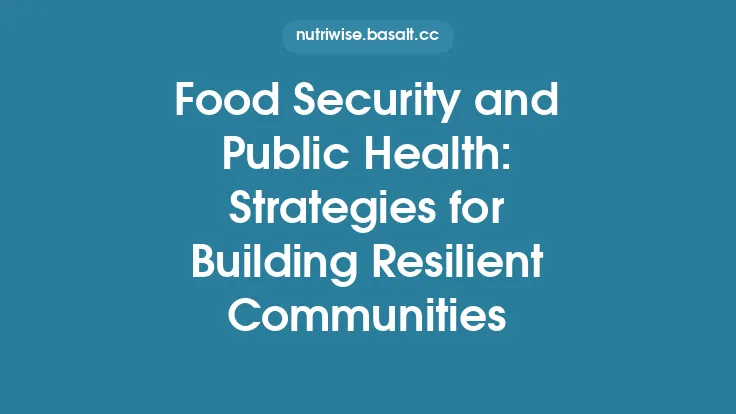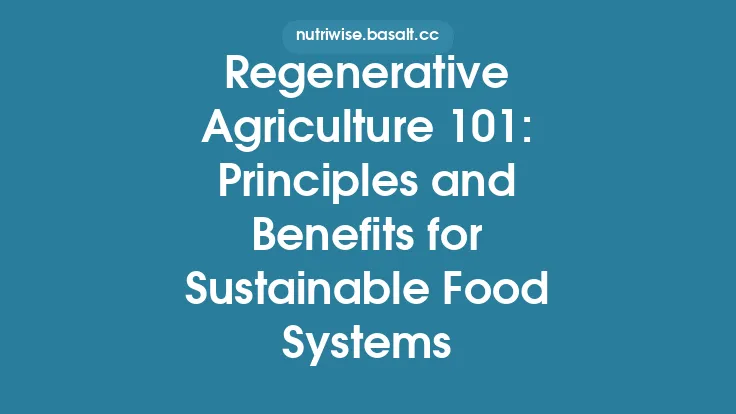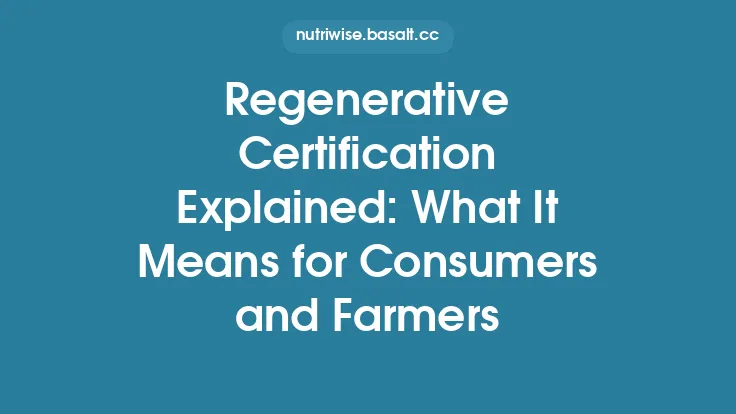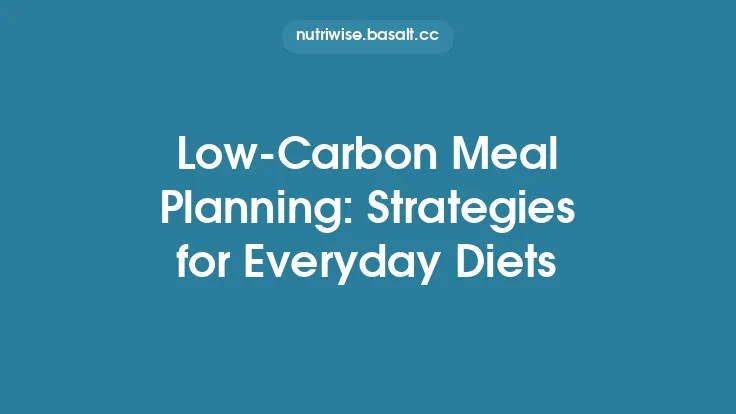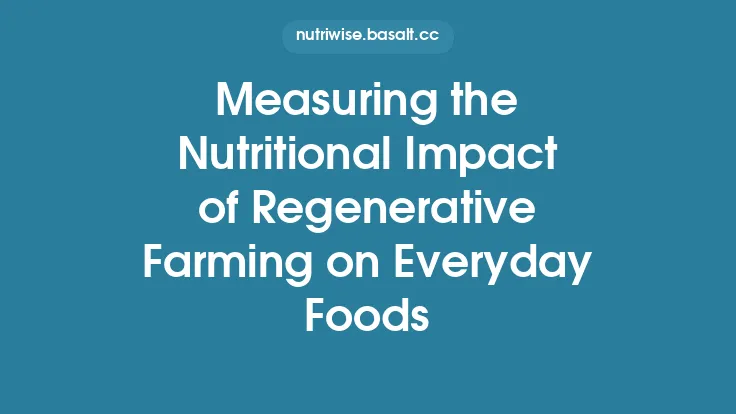In regenerative farming, water is not merely an input to be applied; it is a dynamic resource that interacts with soil, plants, and the broader landscape. Managing water wisely is essential for building resilient yields that can withstand climate variability, drought, and extreme precipitation events. This article explores the core principles and practical techniques that enable farmers to capture, store, and use water efficiently while enhancing soil health, biodiversity, and ecosystem services.
Understanding Water Dynamics in Regenerative Systems
Regenerative agriculture treats the farm as a living hydrological system. Water moves through three primary pathways: infiltration into the soil profile, storage within the soil matrix, and runoff across the surface. The balance among these pathways determines how much water is available to crops during critical growth stages. Key concepts include:
- Infiltration Rate – the speed at which water enters the soil. Faster infiltration reduces surface runoff and erosion.
- Field Capacity – the amount of water the soil can hold against gravity after excess water has drained. Soils with higher field capacity provide a buffer during dry periods.
- Plant‑Available Water (PAW) – the fraction of water held between field capacity and the wilting point that plants can actually extract.
- Hydraulic Conductivity – a measure of how easily water moves through soil pores; influenced by texture, structure, and organic matter content.
By quantifying these parameters, farmers can design interventions that align water movement with crop demand, thereby minimizing waste and maximizing resilience.
Soil Health as the Foundation of Water Retention
Healthy soils are the cornerstone of effective water management. Several soil attributes directly influence water dynamics:
- Organic Matter Content – Organic matter acts like a sponge, increasing both water‑holding capacity and aggregate stability. A 1 % rise in soil organic carbon can boost PAW by roughly 5 % in loamy soils.
- Soil Structure and Aggregation – Well‑aggregated soils contain a network of macro‑ and micro‑pores that facilitate rapid infiltration while retaining moisture in finer pores.
- Biological Activity – Earthworms, mycorrhizal fungi, and microbial exudates create biopores and mucilage that improve water flow and retention.
- Soil Texture – While texture is largely inherent, regenerative practices can modify the effective texture by increasing the proportion of stable aggregates.
Practical steps to enhance these attributes include:
- Regular Organic Amendments – Applying compost, biochar, or green manures to raise organic matter.
- Reduced Tillage – Minimizing soil disturbance preserves structure and biopores.
- Diverse Crop Rotations – Even though detailed rotation strategies are covered elsewhere, rotating deep‑rooted and shallow‑rooted species in a balanced way can improve vertical water distribution.
- Cover Crop Residue Management – Leaving residues on the surface adds mulch (discussed below) and contributes organic inputs.
Designing Landscape for Water Capture
The farm’s topography dictates where water naturally accumulates or drains. Strategic landscape design can redirect excess water to where it is most needed:
- Contour Farming – Aligning planting rows along natural contour lines slows water flow, encouraging infiltration.
- Keyline Design – Developed by P.A. Yeomans, keyline plowing creates a series of shallow channels that spread water laterally across the slope, reducing runoff and enhancing uniform soil moisture.
- Swales and Infiltration Trenches – Shallow, vegetated ditches placed on contour capture runoff, allowing it to percolate slowly into the soil. Swales can be lined with native grasses or legumes to stabilize the surface and add nitrogen.
- Terracing – In steeper terrains, stepped terraces transform a slope into a series of flat benches, dramatically increasing infiltration area.
When implementing these features, it is essential to conduct a site‑specific water balance analysis, considering rainfall intensity, soil infiltration capacity, and the desired storage volume.
Mulching and Surface Management
Mulch serves multiple water‑related functions:
- Evaporation Reduction – A continuous mulch layer can cut soil evaporation by 30–50 % in arid climates.
- Temperature Moderation – Cooler soil temperatures reduce water stress on roots.
- Weed Suppression – Fewer weeds mean less competition for water.
Mulch materials can be organic (straw, wood chips, shredded leaves) or inorganic (plastic films). Organic mulches decompose over time, adding organic matter and further improving water retention. In regions with limited organic waste, biodegradable mulches made from plant‑based polymers provide a temporary barrier without long‑term residue.
Integrating Agro‑hydrological Features
Beyond swales and terraces, regenerative farms can incorporate a suite of water‑focused structures:
- Ponds and Farm Dams – Surface water storage that can be used for supplemental irrigation, livestock, or wildlife habitat. Properly sized ponds also act as sediment traps, improving downstream water quality.
- Rain Gardens – Shallow depressions planted with water‑tolerant species that capture and infiltrate stormwater.
- Permeable Pathways – Using gravel or stabilized soil for farm roads and walkways reduces compaction and allows water to infiltrate rather than run off.
- Subsurface Drainage (Tile Drainage) – Used judiciously – While conventional tile drainage can exacerbate water loss, controlled subsurface drainage with adjustable gates can release water during dry periods, turning a traditionally negative practice into a water‑management tool.
Designing these features requires a holistic view of the farm’s water budget, ensuring that capture capacity matches the expected precipitation patterns and that storage does not create water‑logging risks.
Managed Irrigation Techniques
Even the most water‑wise regenerative system may need supplemental irrigation during prolonged dry spells. The goal is to apply water only when and where it is needed:
- Deficit Irrigation – Deliberately allowing a controlled level of water stress during non‑critical growth stages to improve root depth and water use efficiency.
- Drip Irrigation with Soil Moisture Sensors – Low‑volume, point‑source delivery minimizes evaporation. Coupling drip lines with real‑time soil moisture data (e.g., capacitance probes) enables precise scheduling.
- Scheduled Irrigation Based on Crop Phenology – Understanding the water demand curve of each crop stage (germination, vegetative growth, flowering, grain fill) allows targeted irrigation that maximizes yield while conserving water.
- Irrigation Water Quality Management – Monitoring salinity, pH, and nutrient levels prevents soil degradation and ensures that applied water contributes positively to plant health.
When possible, prioritize using harvested rainwater or stored pond water over municipal supplies to reduce the farm’s external water footprint.
Rainwater Harvesting and Storage
Collecting rainwater directly from rooftops or catchment basins provides a reliable supplemental source:
- Rooftop Harvesting Systems – Gutters, downspouts, and first‑flush diverters channel water into storage tanks. Filtration (mesh screens, sediment traps) protects water quality.
- Underground Cisterns – Buried tanks reduce evaporation and maintain cooler water temperatures, which can be advantageous for certain irrigation systems.
- Modular Storage – Using a series of smaller tanks allows flexibility in scaling storage capacity as the farm expands.
- Water Quality Monitoring – Regular testing for microbial contamination, especially if water will be used for edible crops, ensures safety.
Integrating harvested rainwater with on‑farm distribution networks (gravity‑fed drip lines, low‑pressure pumps) creates a closed‑loop system that reduces reliance on external water sources.
Monitoring and Adaptive Management
Regenerative water management is an iterative process. Continuous data collection informs adjustments:
- Soil Moisture Sensors – Installed at multiple depths to capture the vertical moisture profile. Wireless networks can transmit data to a central dashboard.
- Weather Stations – On‑site measurement of rainfall, temperature, humidity, and wind speed provides the context needed for irrigation decisions.
- Remote Sensing – Satellite or drone‑based NDVI (Normalized Difference Vegetation Index) and thermal imagery can identify water stress across large fields.
- Water Balance Modeling – Simple spreadsheet models or more sophisticated tools (e.g., AquaCrop, SWAT) simulate inflows, outflows, and storage, helping to predict deficits or surpluses.
Adaptive management involves reviewing these data regularly, testing new practices on small plots, and scaling successful interventions farm‑wide.
Case Studies and Practical Implementation
Case 1: Semi‑Arid Wheat Farm in the Pacific Northwest
*Implemented keyline plowing across 150 ha, added 30 m wide swales on 20 % of the land, and installed a 500 kL underground cistern for rainwater capture.*
Result: Infiltration rates increased from 5 mm h⁻¹ to 12 mm h⁻¹, and the farm reduced supplemental irrigation by 40 % while maintaining a 5 % yield increase over three years.
Case 2: Mixed‑Fruit Orchard in the Mediterranean
*Adopted a combination of mulching with shredded olive pomace, drip irrigation linked to soil moisture sensors, and a series of shallow ponds for winter water storage.*
Result: Evapotranspiration demand was met with 30 % less water than the previous conventional system, and fruit size and sugar content improved due to more stable soil moisture.
Case 3: Large‑Scale Soybean Operation in the Brazilian Cerrado
*Integrated contour planting with vegetated buffer strips, constructed 10 m deep infiltration basins, and used a solar‑powered pump to draw water from a central reservoir for targeted deficit irrigation.*
Result: Soil organic carbon rose from 1.2 % to 1.8 % over five years, and water use efficiency (kg yield mm⁻¹) increased by 22 %.
These examples illustrate that water management strategies can be tailored to diverse climates, soils, and crop systems while delivering measurable benefits.
Future Directions and Emerging Technologies
Regenerative water management continues to evolve as new tools and scientific insights emerge:
- Smart Soil Sensors with AI Integration – Machine‑learning algorithms can predict optimal irrigation windows based on multi‑year weather patterns and real‑time sensor data.
- Biochar‑Enhanced Infiltration – Incorporating biochar into the topsoil creates a highly porous medium that dramatically improves water holding capacity and reduces leaching.
- Regenerative Water Credits – Emerging market mechanisms reward farms that demonstrably improve watershed health and water availability, providing an additional economic incentive.
- Hybrid Agro‑hydrological Modeling – Combining hydrological models with ecosystem service assessments helps quantify co‑benefits such as carbon sequestration, biodiversity, and flood mitigation.
- Low‑Cost Satellite Soil Moisture Products – New constellations (e.g., SMAP‑2) deliver near‑real‑time soil moisture maps at resolutions suitable for field‑scale decision making.
Adopting these innovations can further enhance the resilience of regenerative farms, ensuring that water remains a regenerative asset rather than a limiting factor.
By viewing water as an integral component of the living farm ecosystem, regenerative producers can implement a suite of complementary strategies—soil health improvement, landscape design, mulching, water capture structures, precise irrigation, and data‑driven management—to secure reliable yields under a changing climate. The synergy among these practices not only conserves water but also builds soil fertility, biodiversity, and long‑term farm viability, embodying the core promise of regenerative agriculture.
